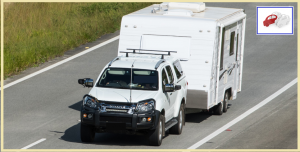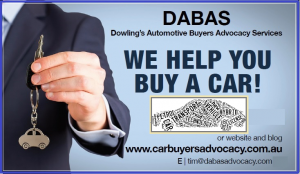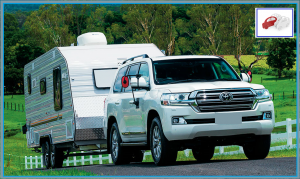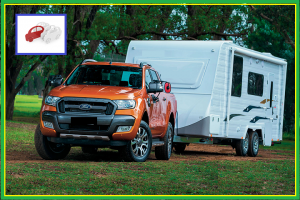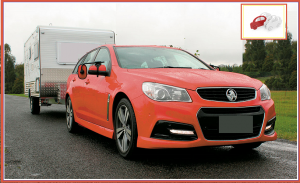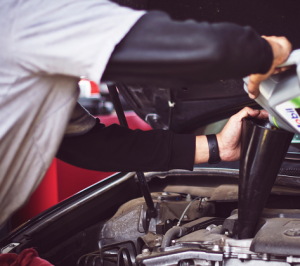DABAS blog post: Early January 2019: Towing safely – some things to be aware of,
Hello readers, “Happy New Year 2019”. At DABAS we hope your Xmas day and New Year’s Eve celebrations all went well. With Xmas lunch and New Year’s celebrations now over, a lot of us look at heading away on a road-trip, often towing caravans or camping-cargo-laden trailers to our favourite holiday destinations. Gone are the days of the summer of 1969, when people thought the family’s Holden Kingswood 308 V8 or the VC VIP Valiant with the 318 V8 could tow anything safely that we cared to hitch up to it. Towing and road-safety awareness campaigns have come a long way in the last 50 years, and in 2019 failure to abide by the Australian Standards towing regulations, including maximum loads, may affect you and your passengers’ and other road-users’ road safety, add to the road trauma toll, result in a fine or vehicle damage, or also, in the case of an accident, refusal of the insurance claim, and the on-going possibility of further legal action. With today’s modern-car design, mechanical components and manufacturing techniques, failure to comply with your vehicle manufacturer’s towing specifications can lead to vehicle structure and mechanical components failure and damage, also voiding any new-car warranty remaining on the vehicle. With that in mind, in this blog post, let’s have a very general look at towing with a vehicle, towing acronyms, what they mean, and some things to be aware of for a safer towing journey. We hope you find it an interesting read, whilst shining some light on information that may assist you selecting a suitable safer vehicle for your towing needs, providing some useful “very general-in-nature” information to help you on your vehicle selection and vehicle-buying journey; more detailed information on the topic will be provided upon your transition to becoming a DABAS client.
If you would like DABAS’s assistance buying a car, please click here.
Here we go, some general information to be aware of when towing.
Trailer mass (weight) terminology: ATM, GTM and Tare Weight.
The maximum weight of a trailer is specified as either its Aggregate Trailer Mass (ATM) or Gross Trailer Mass (GTM).
ATM is the combined weight of the trailer and its full load when it is not coupled to a tow vehicle. GTM is the weight of the fully loaded trailer imposed on the trailer’s axle when it is coupled to the tow vehicle. GTM will always be less than ATM as some of the trailer weight is transferred to the tow vehicle when the trailer is coupled to it.
All new trailers (including those that are home or/and individually built) built since August 1989 are required to have a plate, listing, amongst other things, the trailer’s Aggregate Trailer Mass, although some trailer plates will also show the Tare Weight (the un-laden weight of the trailer) and the GTM.
Trailers built before August 1989 may carry little or none of this information. For pre-August 1989 trailers with no plates or documentation, determining specifications can be difficult and you may need to seek professional assistance from a trailer dealer or engineer. The type of braking system fitted to the trailer may provide some guidance to its likely ATM if other information is unavailable.
You must ensure that the towing vehicle has enough capacity to tow the fully laden trailer.
Trailer Ball Load; ball load is the amount of weight the fully laden trailer imposes (vertically) on the tow bar of the tow vehicle. Trailer ball load is not a specification defined by the trailer manufacturer – it is the actual weight imposed on the rear of the tow vehicle and as such is a function of the trailer’s axle position and the way it is loaded. While there is no requirement to list a trailer’s ball load, it can be measured at a weighbridge by disconnecting the fully laden trailer from the tow vehicle and resting only the trailer’s draw bar (via the jockey wheel) on the scales. Alternatively, some caravan dealers have special ball mass scales for this purpose.
Ball load is not usually a critical issue with small trailers unless the tow vehicle has a low-ball load specification, as is the case with many small cars and some European vehicles. However, heavy trailers such as horse floats and caravans often impose quite high ball loads on the tow vehicle. For caravans it’s important to load the van in the same manner every time once the correct ball load is established, as changes in loading patterns can have a dramatic effect. Loads should never be arranged behind a trailer’s axle to counter excessive ball load. This can be very destabilising and potentially dangerous.
It’s important to realise that, like other specifications, the maximum tow ball load must not be exceeded.
Payload; Payload is the trailer’s carry capacity. It’s the difference between its tare weight (un-laden weight) and its ATM. Payload is important for all trailers, but it is critical to campers and caravans, many of which have quite limited carrying capacity to start with. Modifications and additions to the trailer can very quickly eat into its carrying capacity and result in an overloaded trailer, or the inability to legally carry the important equipment. Additional water tanks and gas cylinders are commonly fitted to campers and caravans and can add significant extra weight. As a guide, each additional litre of water carried adds 1kg (excluding the weight of the water tank and necessary fittings) while each full 9kg gas cylinder adds approximately 18kg (plus the weight of the fittings).
Tow vehicle specifications
Towing capacity; A vehicle’s towing capacity is determined by its manufacturer and is based on factors such as the design of the vehicle, the vehicle’s rear axle load, the capacity of its tyres and the effect the laden trailer will have on the vehicle’s stability, reliability, durability and overall safety. The maximum trailer load will be specified to ensure the combination is controllable and that it will not significantly shorten the life of the vehicle’s body and mechanical components.
Vehicle handbooks generally provide the following information: the maximum weight of the trailer without brakes that can be towed by the vehicle, the maximum weight of a trailer with brakes that can be towed by the vehicle, the maximum tow ball load, and any conditions (such as speed) relating to towing or additional equipment required.
The maximum towing weight specified by the vehicle manufacturer equates to the trailer’s ATM. However, some vehicle manufacturers confuse matters by specifying towing capacity in terms of Gross Trailer Weight, which is another way of saying it refers to the trailer’s Aggregate Trailer Mass. Do not confuse the term Gross Trailer Weight with Gross Trailer Mass as in this regard they are different things. ATM and GTM are generally defined above as well as in the relevant legislation.
Tow ball load; Tow ball load is the proportion of the trailer weight that is applied to the rear of the tow vehicle. A vehicle’s ball load specification will be found in the handbook and will be listed as a weight in kilograms or as a percentage of the trailer’s ATM.
Ball load specifications are often around 10% of the maximum towing mass specification but this isn’t always the case – some may have a lower ball load while others may have a higher ball load. European vehicles can have quite low allowable ball loads in relation to their towing capacity. Too little ball load can cause the trailer to become unstable and too much can be detrimental to the tow vehicle’s durability as well as affecting its stability, steering and braking.
GCVM; Gross Combination Vehicle Mass (where given) is the maximum allowable weight of the trailer, tow vehicle and the load (including passengers) in the tow vehicle and trailer.
Tow vehicle axle load; A maximum axle load specification is sometimes given for vehicles, such as utes, that can carry a load over the rear axle in addition to the load imposed by the trailer (the ball load). In cases where the total of the ball load and the load in the vehicle exceeds the allowable axle load, it will be necessary to reduce the load carried or, in some cases it may be possible to rearrange the trailer’s load, though it will be important to ensure trailer stability is not adversely affected by moving the load too far rearwards.
Towing speeds; Some vehicle manufacturers impose reduced speed limits when towing. This may be across the board or it may be when the weight of the trailer exceeds a certain limit. Where such limits apply, this typically means that the vehicle is restricted to a maximum of approximately 80km/h, so it’s important to factor this into your purchase decision, particularly if you are intending to regularly tow a trailer long distance.
Tow bar specifications; All tow bars made after July 1, 1988, and many made before this date, will have a plate attached that lists the maximum towing weight, the maximum ball load, and the make and model of vehicle the bar was designed for. The vehicle’s specifications will always be the maximum the vehicle can legally tow, even if the tow bar is rated for a higher load. However, if any of the tow-bar specifications are lower than those given for the vehicle, the tow bar’s specification will override the vehicle’s specifications. Note: it is common to find tow-bar specifications that differ from those given for the vehicle. This usually occurs where the bar is made for several different models in the range, or where light- and heavy-duty tow bars are offered for the vehicle.
When dealing with older, unmarked tow bars, it can be difficult to determine the bar’s capacity. It is recommended in this case that you discuss the matter with a VACC-recommended tow-bar manufacturer who may be able to provide professional advice about its suitability for the application.
Trailer information, design rules and legalities;
Vehicle Standards Bulletin 1 is the ‘rule book’ for Australian trailer builders. It contains all the information you need to know about light trailer dimensions, lighting, brakes and much more. The selected vehicle’s owner’s manual will also contain the towing specifications you’ll need to help you in making the right towing decisions. Please note: towing specifications can change from model to model, year to year and even within the same model range. So, it’s vital that you always confirm that the information obtained coincides with that provided in the vehicle’s handbook. If you have any doubt about the accuracy of the information, we recommend confirming it with the vehicle’s manufacturer.
#DABAS free towing tip: Just like the tow vehicle needs regular servicing – so does the trailer or caravan being towed – it should be in full VACC-certified RWC condition and the tyres on it be no more than 5 years old (tyre dealers recommend that even if the tyres still have lots of tread, if they are over 5 years old, they should be replaced) and don’t forget to service the brakes, chassis, hitches, flush brake fluids and check or replace wheel bearings, grease and lube, etc.
Vehicle durability; It’s also worth carefully considering the vehicle’s towing capacity in relation to the trailer’s weight – but not only from a legal perspective. Towing can be hard on a vehicle at any time, but even more so when the trailer is at or close to the maximum capacity of the tow vehicle.
Vehicle durability; While it may be relatively easy to choose a suitable towing vehicle based only on the legal requirements, ensuring that it provides a durable, affordable and reasonably trouble-free choice can be much trickier. There are several factors that need to be balanced in order to achieve a satisfactory outcome.
E.g. A light-duty vehicle, such as a passenger car, may be satisfactory for occasional towing, but if you’re planning to do a lot of heavy or long-distance towing of a horse float or caravan, it’s probably worth considering something a bit more robust.
While a big Ford F150 with a 460 big-block, Dodge RAM or other popular large 4WDs may be a good choice if you plan to do a lot of weekly horse-float towing, it could be a bad choice if you spend 11 months of the year only driving the local school run and the kids’ gymbaroo, salmon swim squad, soccer, AFL, ballet classes or cricket matches around town . . . and not weekly pony club gymkhanas. Increased size, difficulty in parking, high-fuel consumption and more costly maintenance could quickly take the shine off your new vehicle purchase if not properly chosen to suit your real lifestyle.
Vehicle maintenance and repairs; Heavy towing is hard on a vehicle so expect to spend more on fuel, servicing and maintenance if you tow regularly. Most vehicle manufacturers regard towing as severe use and vehicle maintenance schedules usually outline what additional servicing is required. Don’t overlook the fact that things like suspension bushes, components, tyres, brake rotors and brake pads will also wear out faster when towing.
There are of course many vehicles worth checking out if you’re looking to buy a vehicle suitable for towing on Australia’s road network – some of which may be* twins under another brand’s skin (*explained upon your transition to becoming a client of DABAS). Whichever one you end up choosing, DABAS can help do your research, arrange an inspection, check the vehicle’s history, take it on a test drive with you, and help you deal with your paperwork at the LMCT car-yard. At DABAS we know that buying a car to suit your needs can be one of the biggest purchases in your life; we hope this intended to be “general-in-nature advice and information” blog page has provided some helpful assistance for you in deciding the path of your tow-vehicle-buying journey.
Please note: examples, options, pricing and information mentioned in this blog post are to be considered as a very general-in-nature summary; all specifications, information and advice mentioned in this blog page may be outdated or superseded by the time of your reading of this blog page; all information will confirmed at the time of you updating into your next tow-car, along with your chosen vehicle’s sales representative in their LMCT showroom at the time you transition to becoming a client of DABAS.
We look forward to having a chat when the need arises for you to update your car; to assess your personal car-safety requirements and buying needs to suit your lifestyle.
And importantly your set specified budget!
Whatever roads your life journey takes you on, DABAS can help you find a car to travel those roads.
When it comes time to update your car DABAS is aware of some things to consider within these featured model ranges, plus more of the opposition comparisons, things to keep in mind – including when you are trading in your old car at a LMCT used-car yard – and the special trade-in incentives offered on drive-away-no-more-to-pay deals obtainable – at times – within leading brands’ Melbourne LMCT used car dealerships.
These will be discussed upon your transition to becoming a client of DABAS.
To contact DABAS to discuss your car-buying needs, please click here
To see a self-evaluating check list – is it time to update your car – please click here
To see some interesting things to consider when buying a car, please click here
To see 3 things to consider when moving on from your old car, please click here
For a step-by-step example of a DABAS car-buying journey, please click here
For an interesting DABAS blog on tyre safety please click here.
For DABAS past blog topics: see our archived index, please click here
Thanks for visiting DABAS’s website and blog: Have a great day, Cheers, Tim.
Please note: All information mentioned in this blog post is to be considered as a very general-in-nature summary; information mentioned in this blog page may be outdated or superseded by the time you read it.

